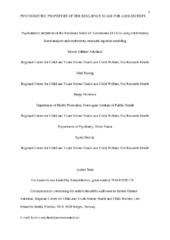Factor Structure and Psychometric Properties of the Resilience Scale for Adolescents (READ)
Peer reviewed, Journal article
Accepted version
Permanent lenke
https://hdl.handle.net/1956/22704Utgivelsesdato
2019Metadata
Vis full innførselSamlinger
Originalversjon
https://doi.org/10.1177/1073191119832659Sammendrag
Psychometric evaluations of the Resilience Scale for Adolescents (READ) have yielded inconsistent support for the original five-factor solution, with different modifications being proposed. The aim of the present article was to investigate the psychometric properties and factor structure of the READ using both confirmatory and exploratory methods, and to evaluate how the scale fits within the theoretical framework of resilience. Data stem from the population-based youth@hordaland-study of 9,596 adolescents from 16 to 19 years of age. Using confirmatory factor analysis, the original five-factor model yielded relatively poor fit. A better model fit was identified for a different five-factor structure using exploratory methods including two new personal factors measuring (a) Goal Orientation and (b) Self-Confidence. This division was supported by low secondary loadings and moderate correlations between the factors, and gender differences in the mean scores. Although the READ is a multidimensional measure that includes individual, family, and social factors related to the resilience process, some important aspects of resilience have not been included.
